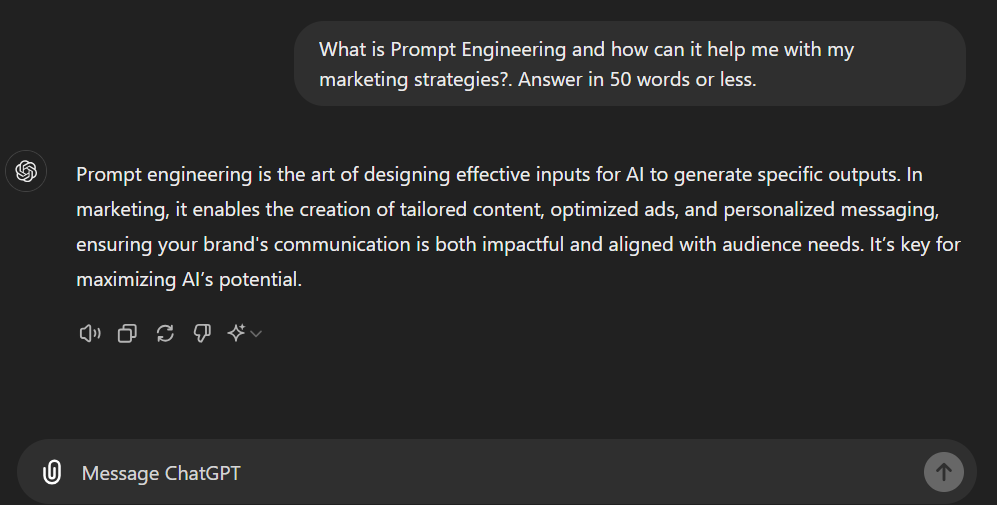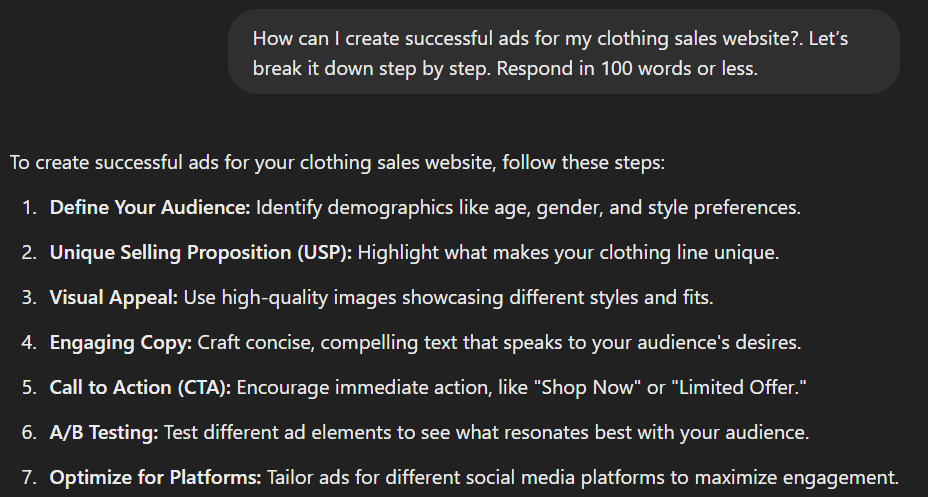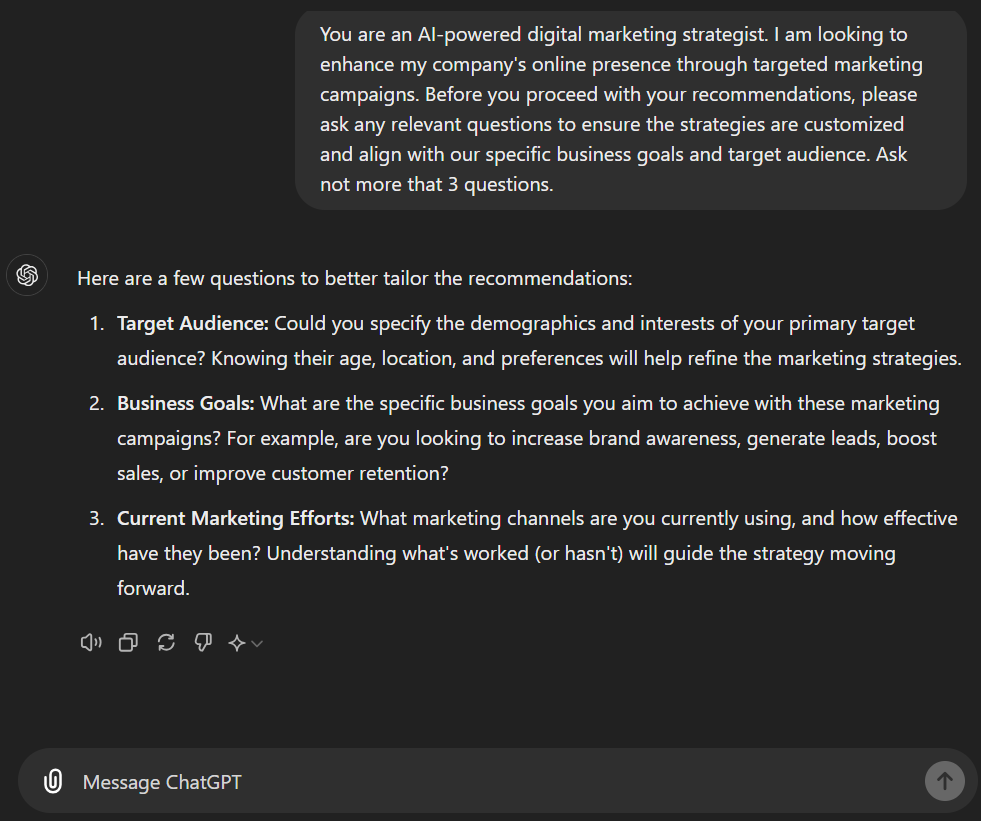Table of Contents
If you’ve ever found yourself struggling to craft the perfect message for your digital marketing campaigns, you’re not alone. The digital landscape is bustling and competitive, making it essential to stand out. That’s where the magic of AI chatbots comes into play, especially when paired with masterful prompt engineering.
In this article, we’ll dive into the nitty-gritty of creating effective prompts that can supercharge your email marketing campaigns, elevate your product descriptions, and make your social media posts pop. Why is this crucial? Because the right prompts can help your AI chatbot generate content that’s not just high-quality, but also perfectly tailored to engage your target audience and drive conversions.
Whether you’re a seasoned marketer or just getting started, mastering prompt engineering with AI chatbots can give your digital marketing strategy a significant edge. Let’s explore how you can harness the power of AI to not just reach but resonate with your audience, turning clicks into customers. Ready to get started?

But first, what is a Prompt?
- A prompt, in the context of artificial intelligence and natural language processing (NLP), is the input or query provided to an AI model, such as ChatGPT or Claude AI, to generate a response. It serves as the initial instruction or question that guides the AI in producing a response.
- Prompt engineering is the art of designing and refining prompts to enhance the performance of natural language processing (NLP) models, such as ChatGPT, Meta AI, Claude, Copilot or virtual assistants. It involves crafting prompts that are clear, concise, and strategically designed to elicit precise and relevant responses. Just as an expertly crafted fishing lure increases your chances of catching the right fish, a well-engineered prompt significantly improves the likelihood of obtaining the desired output from an AI model.
4 Main Steps for Prompting
- Define the Problem or Goal: Clearly articulate what you need assistance with and the type of response you are seeking from the chatbot.
- Incorporate Relevant Keywords and Phrases: Identify and include key industry-specific and topic-related terms in your prompt to guide the chatbot towards generating accurate and relevant responses.
- Craft the Prompt: Write a concise and clear prompt that effectively communicates the required information and task, using the keywords and phrases identified in the previous steps.
- Test, Evaluate, and Refine: Generate responses from the chatbot, assess the outcomes, and adjust the prompt as needed. Continue iterating until you create a prompt that consistently produces the desired results.
Practical Applications in Digital Marketing
Below are the ten most practical applications of prompt engineering in digital marketing:
- Product Descriptions: Generate unique, compelling product descriptions for e-commerce websites to enhance listings and SEO.
- Ad Copy Creation: Craft varied ad copy versions for A/B testing effectiveness in different demographics and platforms.
- Email Campaigns: Automate personalized email content based on customer behavior and preferences to increase engagement.
- Social Media Posts: Create timely, platform-optimized social media content that resonates with target audiences.
- Blog Topic Ideas: Generate a list of blog post topics that align with current trends and audience interests.
- Customer Reviews: Summarize and highlight positive aspects of customer reviews to build trust and social proof.
- Video Scriptwriting: Produce scripts for promotional videos, ensuring brand voice consistency across media types.
- Chatbot Responses: Design nuanced chatbot interactions for customer support, sales, or general inquiries.
- SEO Keyword Integration: Seamlessly integrate targeted SEO keywords into content to improve organic search rankings.
- Brand Storytelling: Develop narratives that align with brand identity for use in multi-channel marketing campaigns.
How to make a good prompt in an AI-Powered Chatbot
The quality of the output depends on the data the model was trained on, its parameters, and the effectiveness of your prompting. Since we can only influence the prompt, here’s what makes a good one:
- Clear and Concise Language: Use direct and unambiguous language to ensure the model understands exactly what you want.
- Persona: Specify the role or persona for the chatbot, guiding how it should respond within your prompt.
- Relevant Input: Provide essential information and examples, utilizing previous chat history if necessary, to give context and clarity.
- Specific Task: Clearly state the task or outcome you want the chatbot to achieve, leaving no room for interpretation.
- Iterative Refinement: Continuously refine your prompt based on initial responses, adjusting until the desired outcome is achieved.

Prompt Examples
- Product Description Enhancement: “Describe the features and benefits of [Product Name], a new eco-friendly cleaning solution, emphasizing its natural ingredients and their effectiveness against common household stains, ideal for social media marketing.”
- Blog Post Ideas for Content Marketing: “Generate five engaging blog post titles for a company specializing in smart home devices, focusing on themes like sustainability, tech innovation, and user-friendly design.”
- Email Marketing Campaign: “Create a three-part email series for an upcoming webinar on the future of blockchain technology. The first email should introduce the webinar and highlight key speakers, the second should provide deeper insights into the topics to be covered, and the third should serve as a final reminder with a call to action to register.'”
- Social Media Interaction Posts: “Craft interactive content for a fitness brand’s Instagram, including polls about workout preferences, Q&A sessions on nutrition, and challenges for followers to post their progress using a specific hashtag.”
- SEO-Optimized Article Starters: “Provide an outline and opening paragraph for an SEO-optimized article titled ‘Top 10 Digital Marketing Trends in 2024’, focusing on new technologies and methods expected to revolutionize the marketing landscape.”
Unlike conventional search engines, AI-Powered chatbots have a unique memory capability that allows it to retain information from previous conversations. This enables the model to reference the entire conversation history when responding to future prompts. This feature is especially valuable because it allows chatbots to grasp context and nuances, leading to more informed and coherent responses as the dialogue progresses. To test this, ask it to review its last response with any of these points:
- Identify the most crucial keywords and format them in bold.
- Organize the content chronologically, by location, or based on relevant categories.
- Generate novel and uncommon results beyond the obvious.
- Add appropriate emojis to enhance the text.
- Simplify the explanation to a comprehension level suitable for a 5-year-old.
- Present the information in tabular format, with relevant headings.
- Rewrite the content from an industry expert’s perspective.
- Adapt the tone to be more formal or informal as needed.
- Correct grammar errors and replace specific terms.
- Infuse personality and humor into the text.
- Write from a specific voice or perspective, such as a character or persona.
- Summarize the content into a tweet-length message.
- Expand the content into a 3-part summary, covering key points.
- Compare and contrast important information within the text.
- Highlight the top 10 takeaways from the material.
- Provide expert recommendations for improvement.
- Create a concise bullet-point list summarizing the main points.
Prompting Framework
This framework introduces a robust structure that is universally applicable to any input and desired output. Its goal is to establish a standardized format that optimizes the framing for the chatbot, thereby enhancing its performance across a wide range of inputs.
Prompt Formula:
- Persona (You are a seasoned content creator)
- Desired output (Write 5 engaging blog posts, each with a clear call to action)
- Purpose of the output (The purpose is to boost interest in my new service)
- Who, what, where, why (These posts should be aimed at my audience of small business owners and should maintain a professional yet approachable tone.)
- Limitations and guidelines (Each post must be concise, keeping within a 300-word limit.)
Example: “You are a seasoned content creator. Write 5 engaging blog posts, each with a clear call to action. The purpose is to boost interest in my new service. These posts should be aimed at my audience of small business owners and should maintain a professional yet approachable tone. Each post must be concise, keeping within a 300-word limit.”
Shot Prompting
There are three types of shot prompting: zero-shot, one-shot, and few-shot prompting:
- Zero-shot prompting: Allowing complete autonomy to generate a response without any specific guidance or examples.
- Prompt Example: “Generate a promotional email for a new AI-driven analytics tool that helps marketers track consumer behavior across multiple platforms.”
- One-shot prompting: Providing a single example or context to guide chatbot’s response within defined parameters.
- Prompt Example: “Given the example of a promotional email below for a digital marketing course, create a similar email for a new AI-driven analytics tool that helps marketers track consumer behavior across multiple platforms. Example Email: Subject: Elevate Your Digital Marketing Skills! Discover our Comprehensive Online Course Today. Hi [Name], Are you looking to boost your digital marketing skills? Our new online course covers everything from SEO to social media marketing. Enroll now and start mastering digital marketing today! Best, [Your Company Name]“
- Few-shot prompting: Offering multiple examples or reference data to shape chatbot’s response more precisely, allowing for nuanced and context-aware outputs.
- Prompt Example: “Given the examples of promotional emails below, create a new email for an upcoming webinar on leveraging AI for marketing analytics. Example 1: “Subject: Join Our Free Webinar on SEO Best Practices. Learn from experts about the latest in SEO and improve your website rankings. Register today!“. Example 2: “Subject: Don’t Miss Our Social Media Strategies Webinar. Enhance your brand presence and engagement on social media with tips from leading experts. Secure your spot now! Create a similar promotional email for: Subject: Upcoming Webinar: Harness AI for Superior Marketing Analytics. Discover how AI can transform your marketing strategy. Register now to learn from the best in the field.“”
Let’s break it down step by step
This framework serves as a technique for the AI-Powered chatbots to provide explanations in a step-by-step format, revealing its reasoning process. By doing so, the model ensures transparency and enhances the comprehensibility of its answers, making them more valuable for educational or explanatory purposes.
[Your question]. Let’s break it down step by step.
Prompt Example: “How can I create successful ads for my clothing sales website?. Let’s break it down step by step.”

Ask for clarification before giving an answer
This framework encourages the AI-powered chatbot to seek clarification before providing answers. By doing so, it ensures that the model’s responses are accurate and specific.
Prompt Example: “You are an AI-powered digital marketing strategist. I am looking to enhance my company’s online presence through targeted marketing campaigns. Before you proceed with your recommendations, please ask any relevant questions to ensure the strategies are customized and align with our specific business goals and target audience.”

As the field of AI continues to evolve, staying updated with the latest strategies and best practices in prompt engineering will be essential. We encourage you to experiment with different approaches, share your insights, and continue exploring how to optimize AI performance through effective prompting.

